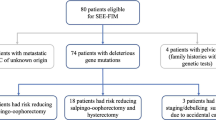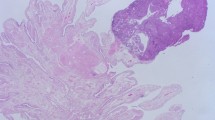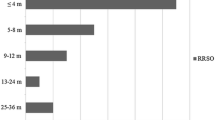Abstract
Risk-reducing salpingo-oophorectomy (RRSO) is widely used for cancer risk reduction in BRCA1 or BRCA2 (BRCA1/2) mutation carriers. Occult ovarian/fallopian tube cancers (OOC) detected at the time of RRSO have been reported in several studies with wide variability in reported prevalence. We estimated the prevalence of OOC in a prospective cohort of 647 BRCA1/2 mutation carriers from 18 centers (PROSE consortium) who underwent RRSO between 2001 and 2008. OOC was detected in 16 of 647 women (2.5%). The mean age at RRSO was 51.7 in those with OOC versus 46.6 in those without OOC (P = 0.017). Twelve of the 16 OOCs (75%) were diagnosed in women with BRCA1 mutations. Thirty-eight percent of women with OOC had stage 1 cancer versus none of the women in the PROSE database diagnosed with ovarian cancer outside of screening. Among 385 women (60%) in whom pathology reports were available for central review, 246 (64%) RRSOs were performed at participating PROSE centers while 139 (36%) were performed at local sites. Ovarian and fallopian tube tissues removed at major genetics referral centers were significantly more likely to have been examined in toto compared to specimens obtained at non-referral centers (75% vs. 30%, P < 0.001). Our results confirm that OOC may be found at the time of RRSO in BRCA1/2 mutation carriers and suggest that OOC are of a more favorable stage than cancers found outside RRSO. An unacceptably high proportion of pathologic examinations did not adequately examine ovaries and fallopian tubes obtained at RRSO.
Similar content being viewed by others
References
Eisen A, Lubinski J, Klijn J, Moller P, Lynch HT, Offit K, Weber B, Rebbeck T, Neuhausen SL, Ghadirian P et al (2005) Breast cancer risk following bilateral oophorectomy in BRCA1 and BRCA2 mutation carriers: an international case–control study. J Clin Oncol 23(30):7491–7496
Robson M, Offit K (2007) Clinical practice. Management of an inherited predisposition to breast cancer. N Engl J Med 357(2):154–162
Rebbeck TR, Kauff ND, Domchek SM (2009) Meta-analysis of risk reduction estimates associated with risk-reducing salpingo-oophorectomy in BRCA1 or BRCA2 mutation carriers. J Natl Cancer Inst 101(2):80–87
Domchek SM, Friebel TM, Neuhausen SL, Wagner T, Evans G, Isaacs C, Garber JE, Daly MB, Eeles R, Matloff E et al (2006) Mortality after bilateral salpingo-oophorectomy in BRCA1 and BRCA2 mutation carriers: a prospective cohort study. Lancet Oncol 7(3):223–229
Parker WH, Broder MS, Chang E, Feskanich D, Farquhar C, Liu Z, Shoupe D, Berek JS, Hankinson S, Manson JE (2009) Ovarian conservation at the time of hysterectomy and long-term health outcomes in the nurses’ health study. Obstet Gynecol 113(5):1027–1037
Rebbeck TR, Friebel T, Wagner T, Lynch HT, Garber JE, Daly MB, Isaacs C, Olopade OI, Neuhausen SL, van ‘t Veer L et al (2005) Effect of short-term hormone replacement therapy on breast cancer risk reduction after bilateral prophylactic oophorectomy in BRCA1 and BRCA2 mutation carriers: the PROSE Study Group. J Clin Oncol 23(31):7804–7810 Epub 2005 Oct 7811
Eisen A, Lubinski J, Gronwald J, Moller P, Lynch HT, Klijn J, Kim-Sing C, Neuhausen SL, Gilbert L, Ghadirian P et al (2008) Hormone therapy and the risk of breast cancer in BRCA1 mutation carriers. J Natl Cancer Inst 100(19):1361–1367
Carcangiu ML, Peissel B, Pasini B, Spatti G, Radice P, Manoukian S (2006) Incidental carcinomas in prophylactic specimens in BRCA1 and BRCA2 germ-line mutation carriers, with emphasis on fallopian tube lesions: report of 6 cases and review of the literature. Am J Surg Pathol 30(10):1222–1230
Lu KH, Garber JE, Cramer DW, Welch WR, Niloff J, Schrag D, Berkowitz RS, Muto MG (2000) Occult ovarian tumors in women with BRCA1 or BRCA2 mutations undergoing prophylactic oophorectomy. J Clin Oncol 18(14):2728–2732
Kauff ND, Satagopan JM, Robson ME, Scheuer L, Hensley M, Hudis CA, Ellis NA, Boyd J, Borgen PI, Barakat RR et al (2002) Risk-reducing salpingo-oophorectomy in women with a BRCA1 or BRCA2 mutation. N Engl J Med 346(21):1609–1615
Leeper K, Garcia R, Swisher E, Goff B, Greer B, Paley P (2002) Pathologic findings in prophylactic oophorectomy specimens in high-risk women. Gynecol Oncol 87(1):52–56
Rebbeck TR, Lynch HT, Neuhausen SL, Narod SA, Van’t Veer L, Garber JE, Evans G, Isaacs C, Daly MB, Matloff E et al (2002) Prophylactic oophorectomy in carriers of BRCA1 or BRCA2 mutations. N Engl J Med 346(21):1616–1622
Finch A, Beiner M, Lubinski J, Lynch HT, Moller P, Rosen B, Murphy J, Ghadirian P, Friedman E, Foulkes WD et al (2006) Salpingo-oophorectomy and the risk of ovarian, fallopian tube, and peritoneal cancers in women with a BRCA1 or BRCA2 mutation. JAMA 296(2):185–192
Olivier RI, Lubsen-Brandsma LA, van Boven H, van Beurden M (2005) Additional salpingectomy after previous prophylactic oophorectomy in high-risk women: sense or nonsense? Gynecol Oncol 96(2):439–443
Evans DG, Clayton R, Donnai P, Shenton A, Lalloo F (2009) Risk-reducing surgery for ovarian cancer: outcomes in 300 surgeries suggest a low peritoneal primary risk. Eur J Hum Genet 17(11):1381–1385
Klaren HM, van’t Veer LJ, van Leeuwen FE, Rookus MA (2003) Potential for bias in studies on efficacy of prophylactic surgery for BRCA1 and BRCA2 mutation. J Natl Cancer Inst 95(13):941–947
Wacholder S (2004) Bias in intervention studies that enroll patients from high-risk clinics. J Natl Cancer Inst 96(16):1204–1207
Kauff ND, Domchek SM, Friebel TM, Robson ME, Lee J, Garber JE, Isaacs C, Evans DG, Lynch H, Eeles RA et al (2008) Risk-reducing salpingo-oophorectomy for the prevention of BRCA1- and BRCA2-associated breast and gynecologic cancer: a multicenter, prospective study. J Clin Oncol 26(8):1331–1337
Lamb JD, Garcia RL, Goff BA, Paley PJ, Swisher EM (2006) Predictors of occult neoplasia in women undergoing risk-reducing salpingo-oophorectomy. Am J Obstet Gynecol 194(6):1702–1709
Paley PJ, Swisher EM, Garcia RL, Agoff SN, Greer BE, Peters KL, Goff BA (2001) Occult cancer of the fallopian tube in BRCA-1 germline mutation carriers at prophylactic oophorectomy: a case for recommending hysterectomy at surgical prophylaxis. Gynecol Oncol 80(2):176–180
Powell CB, Kenley E, Chen LM, Crawford B, McLennan J, Zaloudek C, Komaromy M, Beattie M, Ziegler J (2005) Risk-reducing salpingo-oophorectomy in BRCA mutation carriers: role of serial sectioning in the detection of occult malignancy. J Clin Oncol 23(1):127–132
Finch A, Shaw P, Rosen B, Murphy J, Narod SA, Colgan TJ (2006) Clinical and pathologic findings of prophylactic salpingo-oophorectomies in 159 BRCA1 and BRCA2 carriers. Gynecol Oncol 100(1):58–64
Hermsen BB, van Diest PJ, Berkhof J, Menko FH, Gille JJ, Piek JM, Meijer S, Winters HA, Kenemans P, Mensdorff-Pouilly SV et al (2006) Low prevalence of (pre) malignant lesions in the breast and high prevalence in the ovary and Fallopian tube in women at hereditary high risk of breast and ovarian cancer. Int J Cancer 119(6):1412–1418
Casey MJ, Synder C, Bewtra C, Narod SA, Watson P, Lynch HT (2005) Intra-abdominal carcinomatosis after prophylactic oophorectomy in women of hereditary breast ovarian cancer syndrome kindreds associated with BRCA1 and BRCA2 mutations. Gynecol Oncol 97(2):457–467
Meeuwissen PA, Seynaeve C, Brekelmans CT, Meijers-Heijboer HJ, Klijn JG, Burger CW (2005) Outcome of surveillance and prophylactic salpingo-oophorectomy in asymptomatic women at high risk for ovarian cancer. Gynecol Oncol 97(2):476–482
Callahan MJ, Crum CP, Medeiros F, Kindelberger DW, Elvin JA, Garber JE, Feltmate CM, Berkowitz RS, Muto MG (2007) Primary fallopian tube malignancies in BRCA-positive women undergoing surgery for ovarian cancer risk reduction. J Clin Oncol 25(25):3985–3990
Levanon K, Crum C, Drapkin R (2008) New insights into the pathogenesis of serous ovarian cancer and its clinical impact. J Clin Oncol 26(32):5284–5293
Karlan BY (2004) Defining cancer risks for BRCA germline mutation carriers: implications for surgical prophylaxis. Gynecol Oncol 92(2):519–520
Eitan R, Soslow R, Lin O, Kauff ND, Liu L, Barakat RR, Chi DS (2006) The significance of cytological mesothelial atypia diagnosed from peritoneal washings performed during risk-reducing salpingo-oophorectomy. Gynecol Oncol 102(2):315–318
Agoff SN, Garcia RL, Goff B, Swisher E (2004) Follow-up of in situ and early-stage fallopian tube carcinoma in patients undergoing prophylactic surgery for proven or suspected BRCA-1 or BRCA-2 mutations. Am J Surg Pathol 28(8):1112–1114
Villella JA, Parmar M, Donohue K, Fahey C, Piver MS, Rodabaugh K (2006) Role of prophylactic hysterectomy in patients at high risk for hereditary cancers. Gynecol Oncol 102(3):475–479
Easton DF, Ford D, Bishop DT (1995) Breast and ovarian cancer incidence in BRCA1-mutation carriers. Breast Cancer Linkage Consortium. Am J Hum Genet 56(1):265–271
Antoniou A, Pharoah PD, Narod S, Risch HA, Eyfjord JE, Hopper JL, Loman N, Olsson H, Johannsson O, Borg A et al (2003) Average risks of breast and ovarian cancer associated with BRCA1 or BRCA2 mutations detected in case Series unselected for family history: a combined analysis of 22 studies. Am J Hum Genet 72(5):1117–1130
Evans GR, Gaarenstroom KN, Stirling D, Shenton A, Maehle L, Dorum A, Steel M, Lalloo F, Apold J, Porteous M et al (2009) Screening for familial ovarian cancer: poor survival of BRCA1/2 related cancers. J Med Genet 46(9):593–597
Acknowledgments
All participants provided written informed consent for participation in this study using protocols approved by the Institutional Review Boards of each contributing institution. In addition, the University of Pennsylvania Institutional Review Board approved the overall data collection and analysis protocol for the collaborative data. This study was supported by grants from the Public Health Service (R01-CA83855 and R01-CA102776 to TRR; CA74415 to SLN), the University of Pennsylvania Cancer Center (to TRR), the Cancer Genetics Network (to SMD and CI) the Dana-Farber Women’s Cancers Program (to JEG), the Department of Defense (DAMD-17-96-I-6088 to AKG; DAMD-17-94-J-4340 and DAMD-17-97-I-7112 to HTL; DAMD-17-03-1-0619 to SMD), The Utah Cancer registry (funded by Public Health Service Grant NO1-CN-6700), the Utah State Department of Health,), the National Cancer Institute (2 P30 CA51008-15 to CI) and the Nebraska State Cancer and Smoking-Related Diseases Research Program (LB595 to HTL). DGE is supported by the NIHR Biomedical Research centre at Central Manchester Foundation Trust. OIO is Doris Duke Distinguished Clinical Scientist. None of these funding agencies had involvement in the study design; collection, analysis, or interpretation of data; in the writing of the report; nor in the decision to submit the paper for publication.
Author information
Authors and Affiliations
Corresponding author
Additional information
This study is conducted for the PROSE Consortium. The details of the PROSE Consortium are listed in Appendix.
Appendix
Appendix
The PROSE Consortium includes the following centers and individuals: Baylor-Charles A. Sammons Cancer Center (Joanne L. Blum, M.D. Ph.D., Becky Althaus, R.N., C.G.C., Gaby Ethington), Baylor College of Medicine (Sharon Plon, M.D., Ph.D., Claire Noll), Beth Israel Deaconess Medical Center (Nadine Tung, M.D.), City of Hope National Medical Center (Jeffery Weitzel, M.D., Veronica Lagos), Creighton University (Henry T. Lynch, M.D., Patrice Watson, Ph.D., Carrie Snyder, B.A.,), Dana Farber Cancer Institute (Judy E. Garber, M.D., M.P.H., Katherine Corso, Kathryn Stoeckert), Duke University (Joellen Schildkraut, Ph.D.), Northshore University Health System (Wendy Rubinstein, M.D., Tina Selkirk), Fox Chase Cancer Center (Mary B. Daly, M.D., Ph.D., Irene Angel), Georgetown University (Claudine Isaacs, M.D., Grace Zawistowski,), Guys and St. Thomas Foundation Trust (Gabriella Pichert, M.D., Caroline Langman, Leena Gohil) Jonsson Comprehensive Cancer Center at the University of California, Los Angeles (Patricia A. Ganz, M.D., Joyce Seldon), Mayo Clinic College of Medicine (Fergus Couch, Ph.D.), Netherlands Cancer Institute (Marc van Beurden M.D., Ph.D., Laura van ‘t Veer, Ph.D.), Royal Marsden Hospital (Rosalind Eeles, M.D., Elizabeth Bancroft), St. Mary’s Hospital (Gareth Evans, M.D., Andrew Shenton), University of Chicago (Shelly Cummings, Olufunmilayo Olopade, M.D.), University of California, Irvine (Susan L. Neuhausen, Ph.D., Linda Steele), University of Pennsylvania (Susan Domchek, M.D., Tara Friebel, M.P.H., Timothy Rebbeck, Ph.D.), University of Texas, Southwestern (Gail Tomlinson, M.D.), University of Vienna (Christian F. Singer, Georg Pfeiler), Women’s College Hospital (Steven A. Narod, M.D.), Yale University (Ellen Matloff, M.S., Karina Brierly).
Rights and permissions
About this article
Cite this article
Domchek, S.M., Friebel, T.M., Garber, J.E. et al. Occult ovarian cancers identified at risk-reducing salpingo-oophorectomy in a prospective cohort of BRCA1/2 mutation carriers. Breast Cancer Res Treat 124, 195–203 (2010). https://doi.org/10.1007/s10549-010-0799-x
Received:
Accepted:
Published:
Issue Date:
DOI: https://doi.org/10.1007/s10549-010-0799-x




